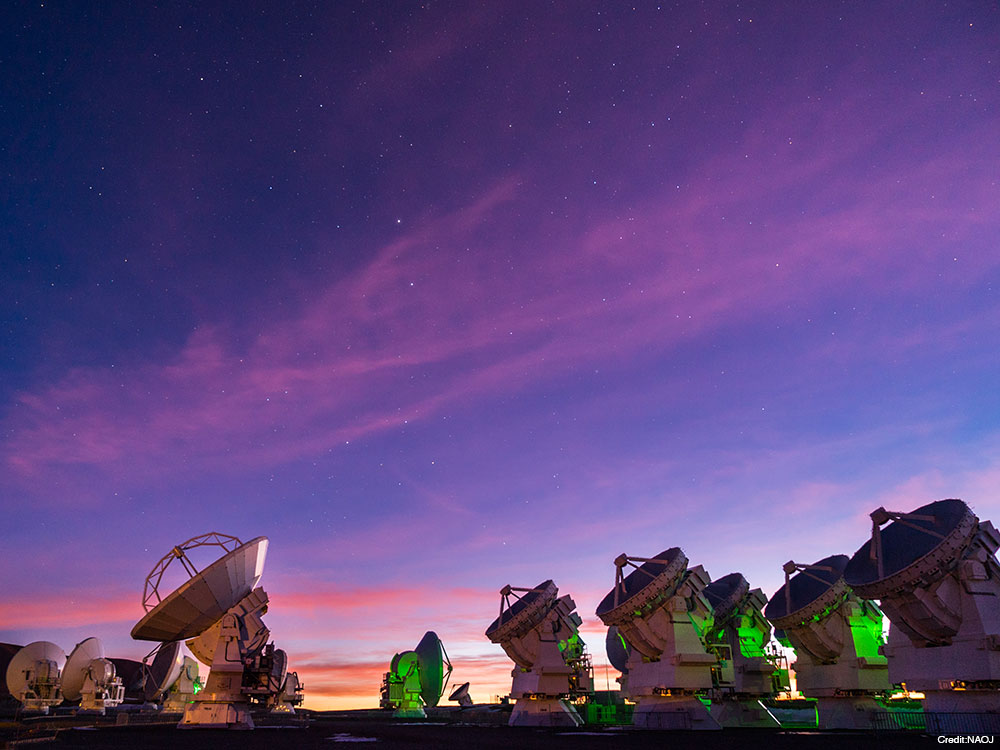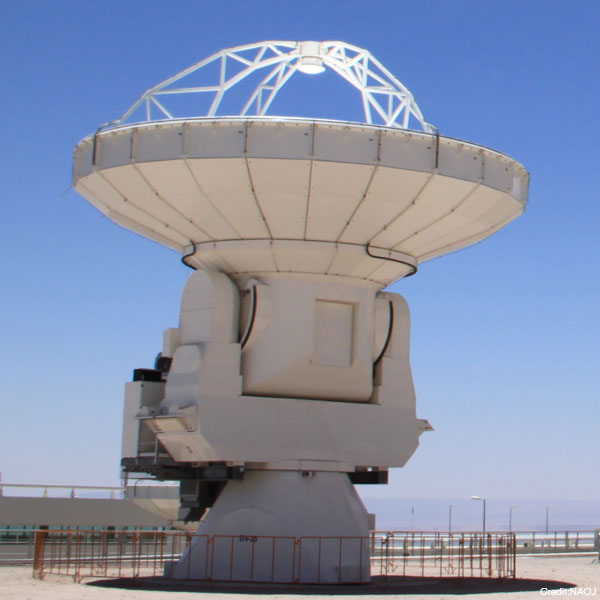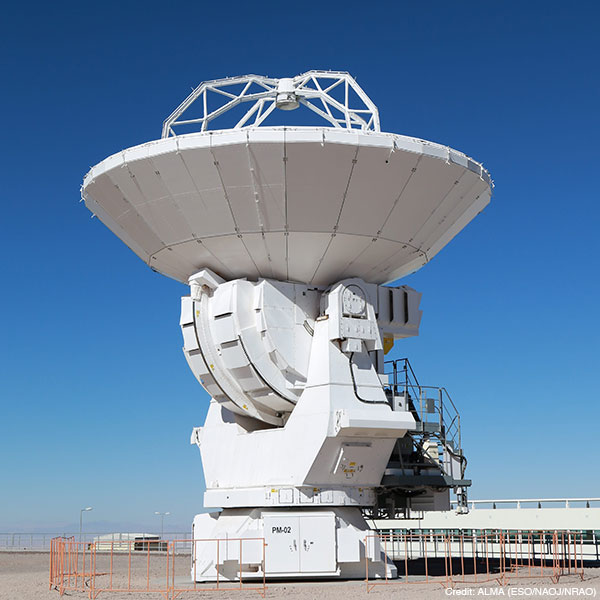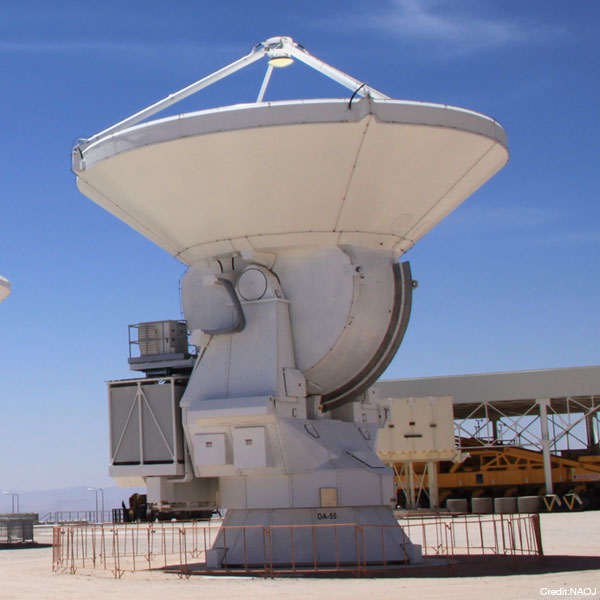What is ALMA?
ALMA (Atacama Large Millimeter/submillimeter Array) is a radio interferometer constructed in the Atacama Desert at 5,000 meters above sea level in the northern Republic of Chile in South America. Scientific observations began in 2011. ALMA is operated by a collaboration of 22 countries and regions, including Japan and East Asia, North America, the member states of the European Southern Observatory, and the host country Chile.
ALMA uses a system called an “interferometer” that arrays many small antennas across a wide area and links them together to operate as one huge telescope. By combining 54 parabolic antennas with 12 meter diameters and 12 parabolic antennas with diameters of 7 meters, ALMA creates one huge radio telescope consisting of 66 antennas in total.
Japan has contributed about a quarter of the overall plan, with 16 out of 66 parabolic antennas and 3 out of 10 types of radio wave receivers, as well as contributing to the development of other types of receivers through international cooperation in East Asia, the United States, and Europe. The supercomputer for processing signals collected by the Japan-made antennas was also developed by Japan. A spectroscopy instrument was developed through collaboration in East Asia as one of the signal processing functions. ALMA is packed with cutting-edge Japanese technology.

Research
ALMA observes radio waves (specifically “millimeter waves” or the even shorter “submillimeter waves”) which are not visible to humans. By observing millimeter and submillimeter waves emitted from cold gases and dust that do not emit visible light, we can investigate the distribution, movement, and properties of gases and dust. Since gases and dust are the raw materials for stars and planets, questions like how stars and planets are born, or how the galaxies form and evolve have been actively studied using ALMA. In addition, research has been conducted to search for organic molecules such as amino acids related to the origin of life. With high resolution equivalent to 240000/20 vision in terms of eyesight and high sensitivity 100 times greater than a conventional radio telescope, ALMA searches for “our origins” in the Universe.
Specifications

Prime manufacturer: General Dynamics (Vertex Antennentechnik)

Prime manufacturer: Mitsubishi Electric Corporation

Prime manufacturer: AEM Consortium (Thales Alenia Space, European Industrial Engineering, MT-Mechatronics)
| Location | Atacama Desert (Chajnantor Plateau at an altitude of 5000 meters), Republic of Chile |
|---|---|
| Aperture | 12 meters and 7 meters |
| Wavelength | Submillimeter and millimeter |
| Antenna deployment range | Up to 16.2 kilometers |
| Highest resolution | 0.005 arcsec |
History
| 1983 | Establishment of the Japanese “Large Millimeter Array (LMA)” plan which would become the ALMA Project. |
|---|---|
| April 2001 | Japan, the United States of America, and Europe agree to collaborate on the construction of ALMA. |
| March 2002 | In order to conduct observation in submillimeter wavelengths in the southern hemisphere in preparation for ALMA, NAOJ installed the ASTE Telescope with a 10-meter diameter aperture close to where ALMA was being constructed. |
| November 2003 | Groundbreaking ceremony held. |
| September 2004 | Japan officially joins consortium for ALMA construction. Atacama Large Millimeter/submillimeter Array (ALMA) adopted as the official name. |
| January 2010 | Commissioning observations started. |
| March 2010 | “Izayoi (meaning the sixteenth night of a lunar month)” chosen as the nickname of the Japan-made antennas. |
| September 2011 | Early Science observation started with 16 antennas. |
| March 2013 | Inauguration ceremony was held. Transitioned to full scale operation. |
| June 2014 | The last of the 66 antennas installed at the Array Operations Site. |
Related Project
Main Research Results
- ALMA Finds Oxygen 13.28 Billion Light-Years Away - Most Distant Oxygen Indicates Mature Nature of a Young Galaxy (ALMA)
- Revolutionary ALMA Image Reveals Planetary Genesis (ALMA)
- Planet Formation in Earth-like Orbit around a Young Star (ALMA)
- ALMA Finds Ingredient of Life Around Infant Sun-like Stars (ALMA)
- ALMA Spots Possible Formation Site of Icy Giant Planet
- Unprecedented views of lensed galaxy and asteroid Juno taken with ALMA
Among the 66 antennas constituting ALMA, Japan has developed a system consisting of 16 antennas (nicknamed as Izayoi), receivers, and a correlator. This system is called the “Atacama Compact Array (ACA, also nicknamed the Morita Array).” In an “interferometer” radio telescope which links many antennas together as a huge telescope, the wider the antennas are arrayed, the higher the resolution becomes, but the narrower the field of view becomes. On the other hand, in order to observe extended celestial bodies using a wide field of view, it is necessary to reduce the space between the antennas. The Morita Array realized that goal by collecting antennas with small apertures in a small area. The Morita Array was named in memory of NAOJ Professor Koh-ichiro Morita who made a big contribution to its design.
